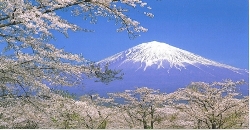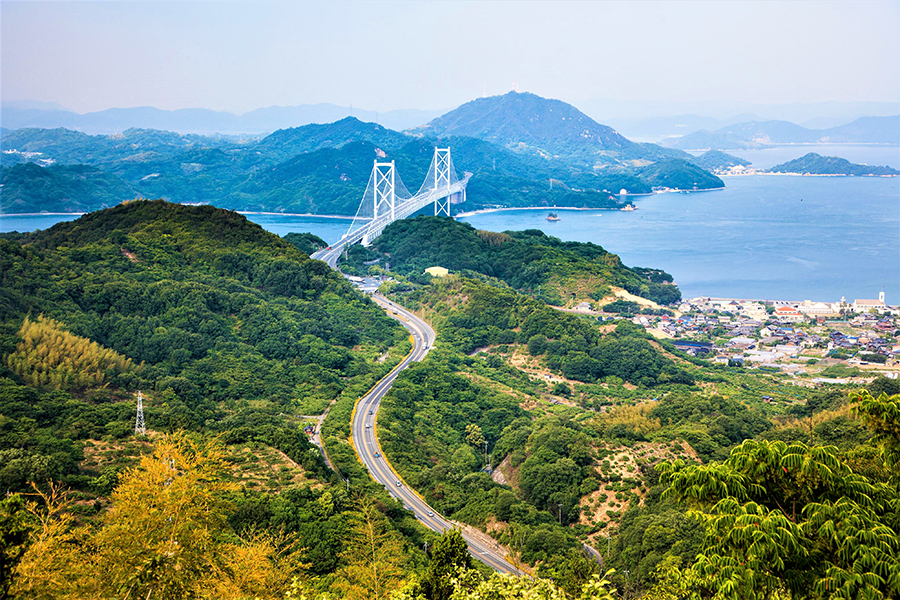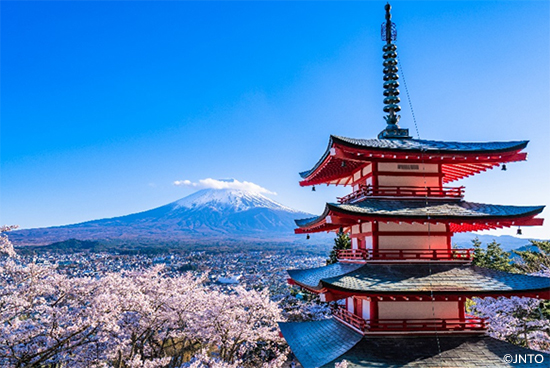January is cold here; word is, February may be colder.
Vacation
David came to Japan on December 17th. I flew to Tokyo and met him at Narita Airport. We spent the night in Tokyo, and then flew to Kagoshima on Sunday morning. That week, David and I went about my (somewhat) normal routine. We went to Junior High, Elementary and Nursery Schools. In the Junior Highs, students practiced English by asking him questions in class. He played Basketball with some of the 3rd years (9th graders in US) and was frequently mobbed in the halls by girls who asked him over and over if he had a girlfriend.
David goes to Japan In Elementary School he helped me teach some of my classes, and hung out with the students during lunch time and recess. There are some pictures on my web site. In Nursery School, he was asked to dress up as a very popular holiday character for the "Christmas Party". I have promised not to divulge exactly which character he dressed up as, so I will not be posting those photos. We had Dinner at the Fugishima's (my host family) house one night. They prepared Sushi and Mrs. Fugishima made tempura right at the dinner table. After dinner Mr. Fugishima showed David the temple that is at the center of their home. I was a little surprised to find that he had a Karaoke machine right there in the temple. Naturally, I sang a song or three as David sat exhausted and freezing by the kerosene heaters. David found that like me, he loves Onsens (hot spring baths). Every night in Asagiri-Cho, we went to the one near my home.
On the first day of my vacation, we drove from my house to Kumamoto City. There we took a ferry to Shinbaya and continued our drive to Nagasaki. This is a fascinating city that is one of Japan's historic points of contact with the west. The first thing we saw was Glover Garden, because all of the teachers and one of the principals told me to see that when in Nagasaki. It is a historic home that was built by a westerner (Mr. Glover) some time ago. The Japanese are fascinated by this house, because of the Western style. To me, it looked much like any of the historic houses in Jersey. For dinner we found a small hole in the wall Sushi restaurant where we had the best Sushi I have had since being in this country. It was just a neighborhood place, but the food was unbelievable. That night we explored Chinatown.
The next day we went to Nagasaki Peace Park. This is a sculpture garden built on the site of a former prison that was the closest building to the Hypocenter. On the ground you can see bits of the foundation that are all that remain after the Bombing. From there we went to the Atomic Bomb Museum. The museum is mostly dedicated to the human tragedy that was suffered in this city. I found it to be quite moving. David and I both noticed the parts that deal with the history of WW2 have a slightly different bend than what we are used to. As a child growing up, I believed that WWII was 80% the Shoah (Holocaust), 10% Pearl Harbor, 8% The Allies liberating the camps and 2% something else in Russia, France, the rest of Europe and Asia. My experience in Japan so far tells me that their take is that the war was about 80% Hiroshima, Nagasaki and the reconstruction, 5% Pearl Harbor, 10% the post war constitution, and maybe 5% Europe, China, Comfort women, Korea and whatever the hell else happened. The Hypocenter is marked by a Black stone pillar standing in an unassuming park near a busy road. There are places for school groups to leave chains of folded paper cranes and a piece of a cathedral damaged by the bombing and other statues. Nagasaki has a number of old churches including the oldest church in Japan, which is a testament to the multicultural nature of this city. There is also a hill, where a number of foreign Christian and Japanese converts were executed during a period when the practice of other religions was forbidden by the Emperor. I believe it was not meant to be irony (as there is not much appreciation for things ironic in Japan), but the execution of these individuals was carried out by means of crucifixion. In the afternoon, we went to the small Degima Island. This was once the only place where foreigners were allowed to live in Japan. Only male traders were permitted on this island and the only Japanese allowed to see them were registered traders and prostitutes. The houses here are built in a classic Dutch style.
To this day, any western style houses in Japan are called Hollanders. Later we went to the Hamanomachi covered shopping area. Here we found a Jewelry shop with large Mezuzahs on each door. Curious, I asked the Japanese woman running the shop if she knew what they were. She asked in perfect English: "Where are you from?" I told her, and then she asked, "Are you Jewish?" She then demonstrated what it was by kissing the Mezuza. It turns out the proprietor of that shop is part of a small Jewish community in Nagasaki. Who knew? On Christmas day we took the ferry back to Kumamoto and saw Kumamoto Castle and the Museum. The Museum has a cool high tech ping pong table that recognizes where the ball has hit, and projects different light patterns on the table based on some programs. David was impressed with the table, though not with my playing of ping pong. That night we had dinner at a Mexican restaurant. David was able to order something off the menu using his Spanish which seemed to impress the restaurateur.
Volcano Sakurajima The next day we drove down to Kagoshima. We took a ferry to Sakurajima, the active Volcano in Kagoshima's bay. We took a taxi to an observation post near the Volcano. Later we went to an Onsen at the base of the island, near the ferry terminal. The following day we took a train to Ibusky, a town an hour outside of Kagoshima. In Ibuski we experienced the famous, Hot Sand Baths. We were covered to the neck with special hot sand and relaxed while the sand did whatever it is supposed to do. After about 10 minutes we went back inside for an Onsen. That night we went to what our hotel proprietor said was a quite nice Onesen. It was actually a little hole in the wall that could have used a week worth of cleaning. After a quick dip in the literally boiling water I urged David out the door when three men with full back tattoos walked in. Tattoo lovers in Japan will cover their bodies everywhere except for their backs, so they will never be mistaken for members of the Yakuza. Such body art indicates member in this Mafia organization. I chose not to seek out their views on sharing bath water with dirty foreigners. Tokyo is a happening town. Not exactly my kind of happening, but happening. This is one of the world's largest cities by population.
On Friday we went to the Tskigi Fish Market. This place is massive, really quite large. As best as I could count the market spreads over some 4 city blocks, but it may actually be larger. We started our day at about 4:30am so we could see the market with all the hustle and bustle. Giant frozen tuna are laid out in big rooms with cement floors. Japan imports fish from all over the globe. These tuna come in on boats and are flown in daily. This is the largest fish market on earth. The fish are transported around the market on these small gas powered carts. Judging by the reckless speed at which they are driven, I would assume the drives are paid per load that they ferry. After walking around for an hour or more, we found a small sushi restaurant for breakfast. The sushi was quite forgettable, so we spent the rest of the day eating sushi in other restaurants throughout the city.
Tokyo Tower After the market we headed to the Tokyo Tower and arrived just as they were getting ready to open. This building is quite similar to the Eiffel tower in every way other than being a few feet taller and having been painted red and white. The view from the top is impressive and more than a little terrifying for an Acrophobic. Later, we went to the Imperial Palace, which can only be partially viewed from across a wide moat. On December 31st we went to the Asusaksa, which is recognizable from any pictures or videos you may have seen about Japan. Here we saw some shrines and other neat buildings. In the evening we headed to Ropongi. This is the part of town to be in for a party on New Year's Eve. We were told to go to a club called Vanilla where all the foreigners are known to hang, but by 11:30, the line to get in made it impossible for us to be inside by midnight. So, we went to another club down the block called Alfie. The line here wasn't so bad, but as we were waiting we noticed that security was checking everyone's ID's. I gave David my NJ drivers license, and first showed the guard my own Foreign Residents Registration Card. He let me through with no problem, and then looked at "David's card". He had difficulty finding the birth date, so when he finally found it, he evidently forgot that he had, only seconds earlier, seen the exact same date. He bowed, apologized for the delay and we were in. When David asked how we had gotten away with that, I explained that, "White people all just look the same." On New Year's Day David went home and I came back down here. It was sad seeing him go. I spent the next 3-4 days sleeping.
Coming of age Day
In early January I attended a ceremony to mark Coming of Age day. This is a ceremony that takes place all over Japan in every town to honor those people who had turned 20 in the previous year. Twenty is the age when they can vote, drink and smoke, and is also the age at which they are considered full adults. The ceremony is a big deal for the families. Girls are given expensive kimonos by their parents (usually the first one they will own), frequently costing thousands of dollars. The boys dress in expensive suits. The ceremony took place in a large auditorium. The 20 year olds sit down front and are addressed by leaders of the community. After the ceremony people asked me what coming of age day is like in America. I tried to explain the Bar-Mitzvah.
Decision Time
By February 3rd (Friday) I will need to decide weather or not to stay here for a second year. This has been an excruciatingly difficult decision process. If I decide to stay, I will be here for an additional 18 months versus 6 months if I chose not to re-contract. If I decide to re-contract and later change my mind, my town will likely loose its ability to get a new ALT for next year. If I say I won't stay, that also becomes unchangeable. Man, it is a difficult thing to figure out what I should do. I don't know what I want to do this weekend: how in the hell can I make plans for the next year and a half?! At least it will be over, one way or another, tomorrow.
http://www.jewinjapan.com/
Josh Bernstein JETAA 2005-2006 Asagiri, Kumamoto Prefecture



















































